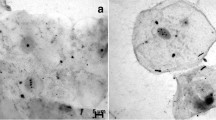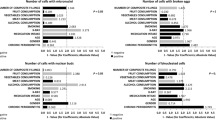Abstract
Background
Nucleolus organizer regions (NORs) consist of the rRNA coding gene family (rDNA) in the cell nucleus. The argyrophilic proteins are selectively stained with silver nitrate and bind these regions. It was reported that NOR (rDNA) activity decreases in human lymphocytes, fibroblasts and bone marrow with age. However, to our knowledge there have not been any studies related to the NORs in oral epithelial cells of healthy individuals.
Aim
Our aim is to detect any correlation between age and Total AgNOR area/Total nucleus area (TAA/TNA) values in buccal epithelial cells of healthy individuals.
Methods
Oral epithelial cells from 50 healthy individuals (age range of 2–80 years old) were spread onto a clean glass slide, air dried and fixed. Then the AgNOR staining protocol was performed on these cells. TAA/TNA ratio and AgNOR dots were calculated using software. From each person 50 oral epithelial cells were evaluated.
Results
Statistically significant correlations were found between mean TAA/TNA values and age (Rsq = 0.534, p < 0.001 for linear and Rsq = 0.728, p < 0.0001 for polynominal regression), and between AgNOR number and age (Rsq = 0.621, p < 0.001 for linear and Rsq = 0.693, p < 0.0001 for polynominal regression).
Conclusion
There is a significant correlation between age and AgNOR amount (ribosome biosynthesis rate) in buccal epithelial cells of healthy individuals. AgNORs in buccal epithelial cells may be used for detection of age.







Similar content being viewed by others
References
Caburet S, Conti C, Schurra C, Lebofsky R, Edelstein SJ, Bensimon A (2005) Human ribosomal RNA gene arrays display a broad range of palindromic structures. Genome Res 15:1079–1085. doi:10.1101/gr.3970105
Hernandez-Verdun D (2006) The nucleolus: a model for the organization of nuclear functions. Histochem Cell Biol 126:135–148. doi:10.1007/s00418-006-0212-3
Ploton D, Menager M, Lechki C, Jeannesson P, Visseaux B, Adnet JJ (1988) Silver staining of nucleolus organizer regions (NORs). Application to the study of nucleolar structure and value in pathology. Ann Pathol 8(3):248–252
Leung AK, Andersen JS, Mann M, Lamond AI (2003) Bioinformatic analysis of the nucleolus. Biochem J 376(3):553–569. doi:10.1042/BJ20031169
Andersen JS, Lam YW, Leung AK, Ong SE, Lyon CE, Lamond AI, Mann M (2005) Nucleolar proteome dynamics. Nature 433(7021):77–83. doi:10.1038/nature03207
Coute Y, Burgess JA, Diaz JJ, Chichester C, Lisacek F, Greco A, Sanchez JC (2006) Deciphering the human nucleolar proteome. Mass Spectrom Rev 25(2):215–234. doi:10.1002/mas.20067
Sirri V, Urcuqui-Inchima S, Roussel P, Hernandez-Verdun D (2008) Nucleolus: the fascinating nuclear body. Histochem Cell Biol 129(1):13–31. doi:10.1007/s00418-007-0359-6
Paiva RL, Sant’ana Filho M, Bohrer PL, Lauxen Ida S, Rados PV (2004) AgNOR quantification in cells of normal oral mucosa exposed to smoking and alcohol. A cytopathologic study. Anal Quant Cytol Histol 26:175–180
Eroz R, Cucer N, Karaca Z, Unluhizarci K, Ozturk F (2011) The evaluation of argyrophilic nucleolar organizing region proteins in fine-needle aspiration samples of thyroid. Endocr Pathol 22:74–78. doi:10.1007/s12022-011-9161-z
Eroz R, Unluhizarcı K, Cucer N, Ozturk F (2013) The value of argyrophilic nucleolar organising region protein determinations in non-diagnostic fine needle aspiration samples (due to insufficient cell groups) of thyroid nodules. Anal Quant Cytol Histol 35(4):226–231
Eroz R, Cucer N, Unluhizarcı K, Ozturk F (2013) Detection and comparison of cutoff values for total AgNOR area/nuclear area and AgNOR number/nucleus in benign thyroid nodules and normal thyroid tissue. Cell Biol Int 37(3):257–261. doi:10.1002/cbin.10038
Trere D (2000) AgNOR staining and quantification. Micron 31:127–131. doi:10.1016/S0968-4328(99)00069-4
Imamoglu N, Demirtas H, Donmez-Altuntas H, Hamurcu Z, Ilten A (2005) NORs Expression increases on metaphase chromosomes of Down syndrome lymphocytes, in concordance with the mitogen concentration in the culture medium. Cytometry Part B Clin Cytom 66B:36–39. doi:10.1002/cyto.b.20050
Cucer N, Imamoglu N, Tozak H, Demirtas H, Sarac F, Tatlısen A, Ozturk F (2007) Two-dimensional AgNOR evaluation as a prognostic variable in urinary bladder carcinoma: a different approach via total agnor area/nucleus area per cell. Micron 38:674–679. doi:10.1016/j.micron.2006.08.002
Eroz R, Tasdemir S, Dogan H (2012) Is there any relationship between decreased AgNOR protein synthesis and human hair loosing? Biotech Histochem 87(8):494–498. doi:10.3109/10520295.2012.698307
Eroz R, Yilmaz S, Cucer N (2013) Argyrophilic nucleolar organizing region associated protein synthesis in hair root cells of humans at different developmental stages and sex. Biotech Histochem 88(5):267–271. doi:10.3109/10520295.2013.769632
Denton TE, Liem SL, Cheng KM, Barrett JV (1981) The relationship between aging and ribosomal gene activity in humans as evidenced by silver staining. Mech Ageing Dev 15(1):1–7. doi:10.1016/0047-6374(81)90002-6
Das BC, Rani R, Mitra AB, Luthra UK (1986) The number of silver-staining NORs (rDNA) in lymphocytes of newborns and its relationship to human development. Mech Ageing Dev 36(2):117–123
Buys CH, Osinga J, Anders GJ (1979) Age-dependent variability of ribosomal RNA–gene activity in man as determined from frequencies of silver staining nucleolus organizing regions on metaphase chromosomes of lymphocytes and fibroblasts. Mech Ageing Dev 11(1):55–75. doi:10.1016/0047-6374(79)90064-2
Pedrazzini E, Mamaev N, Slavutsky I (1998) Age related decrease of NOR activity in bone marrow metaphase chromosomes from healthy individuals. Mol Pathol 51(1):39–42. doi:10.1136/mp.51.1.39
Lindner LE (1993) Improvements in the silver-staining technique for nucleolar organizer regions (AgNOR). J Histochem Cytochem 41:439–445. doi:10.1177/41.3.8429207
Demirtas H, Imamoglu N, Donmez H, Cucer N, Yılmaz A, Candemir Z (2001) Condensed chromatin surface and NOR surface enhancement in mitogen-stimulated lymphocytes of Down syndrome patients. Ann Genet Paris 44:77–82. doi:10.1016/S0003-3995(01)01041-3
Orellana-Bustos AI, Espinoza-Santander IL, Franco-Martinez E, Labos JFN, Ortega- Pinto AV (2004) Evaluation of keratinization and AgNORs count in exfoliated cytology of normal oral mucosa from smokers and non-smokers. Med Oral 9:197–203
Salehinejad J, Kalantari MR, Omidi AA, Zare R (2007) Evaluation of AgNOR staining in exfo- liative cytology of normal oral (buccal) mucosa: effect of smoking. J Mashhad Dent Sch 3:22–24
Mondal NK, Dutta A, Banerjee A, Chakraborty S, Lahiri T, Ray MR (2009) Effect of indoor air pollution from biomass fuel use on argyrophilic nuclear organizer regions in buccal epithelial cells. J Environ Pathol Toxicol Oncol 28:253–259
Roussel P, Belenguer P, Amalric F, Hernandez-Verdun D (1992) Nucleolin is an AgNOR protein: this property is determined by its aminoterminal domain independently of its phosphorylation state. Exp Cell Res 203:259–269. doi:10.1016/0014-4827(92)90063-E
Yilmaz SI, Demirtas H (2008) AgNOR increase in buccal epithelial cells of trisomy 21 infants. Micron 39(8):1262–1265. doi:10.1016/j.micron.2008.03.014
Luke A, Roizen NJ, Sutton M, Schoeller DA (1994) Energy-expenditure in children with down-syndrome—correcting metabolic-rate for movement. J Pediatr 125(5):829–838. doi:10.1016/S0022-3476(06)80193-9
Fernhall B, Figueroa A, Collier S, Goulopoulou S, Giannopoulou I, Baynard T (2005) Resting metabolic rate is not reduced in obese adults with Down syndrome. Ment Retard 43(6):391–400. doi:10.1352/0047-6765(2005)43[391:RMRINR]2.0.CO;2
Derenzini M, Trere AD, Pession A, Govoni M, Sirri V, Chieco P (2000) Nucleolar size indicates the rapidity of cell proliferation in cancer tissues. J Pathol 191:181–186. doi:10.1002/(SICI)1096-9896(200006)
Bouche G, Caizergues-Ferrer M, Bugler B, Amalric F (1984) Interrelations between the mat- uration of a 100 kDa nucleolar protein and pre rRNA synthesis in CHO cells. Nucleic Acids Res 12:3025–3035. doi:10.1093/nar/12.7.3025
Elangovan T, Mani NJ, Malathi N (2008) Argyrophilic nucleolar organizer regions in inflammatory, premalignant and malignant oral lesions: a quantitative and qualitative assessment. Indian J Dent Res 19:141–146
Dayan D, Vered M, Sivor S, Hiss Y, Buchner A (2002) Age-related changes in proliferative markers in labial salivary glands: a study of argyrophilic nucleolar organizer regions (AgNORs) and Ki-67. Exp Gerontol 37:841–850. doi:10.1016/S0531-5565(02)00019-0
Andersen JS, Lyon CE, Fox AH, Leung AKL, Lam YW, Steen H, Mann M, Lamond AI (2002) Directed proteomic analysis of the human nucleolus. Curr Biol 12(1):1–11
Thomas S, Mukherjee AB (1996) A longitudinal study of human age-related ribosomal RNA gene activity as detected by silver-stained NORs. Mech Ageing Dev 92(2–3):101–109. doi:10.1016/S0047-6374(96)01805-2
Borsatto B, Smith M (1996) Reduction of the activity of ribosomal genes with age in Down’s syndrome. Gerontology 42(3):147–154
Acknowledgments
Erciyes University Research Fund has supported this research; contract Grant Number: TSY-08-559. This study is the essential part of the MS thesis of Burak Selvi. The Medical Research Council of Erciyes University (ERUBAP, Project No. TSY-08-559) supported this work.
Conflict of interest
There is no conflict of interest that could be perceived as prejudicing the impartiality of the research reported.
Author information
Authors and Affiliations
Corresponding author
Rights and permissions
About this article
Cite this article
Selvi, B., Demirtas, H., Eroz, R. et al. Reduction of the argyrophilic nucleolar organizing region associated protein synthesis with age in buccal epithelial cells of healthy individuals. Aging Clin Exp Res 27, 201–208 (2015). https://doi.org/10.1007/s40520-014-0263-6
Received:
Accepted:
Published:
Issue Date:
DOI: https://doi.org/10.1007/s40520-014-0263-6




